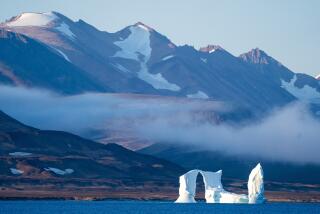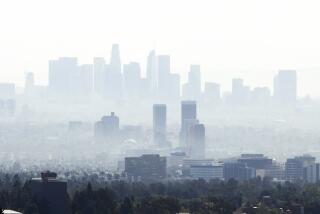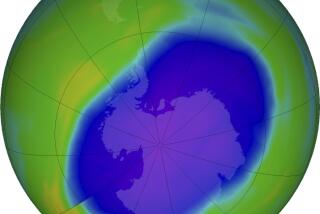Environment : Going to Extremes to Study Ozone : Canadians hunker down at planet’s northernmost inhabited spot to see whether Arctic may develop a dangerous hole in its atmosphere.
ALERT, Northwest Territories — Each week, snow or shine, Valerie Chorney lofts a special weather balloon 130,000 feet into the sky over this, the northernmost inhabited spit of land on the planet.
The balloon is equipped with an ozonesonde, an electrochemically sensitive instrument that measures the vertical distribution of ozone in the upper atmosphere and radios the data back to Earth.
“This baby costs 600 bucks American, and it’s lost every time,” says Chorney’s colleague, Bruce Lowry, holding up the palm-sized ozonesonde in its white styrofoam housing and explaining that when the balloon bursts in the upper atmosphere, the instrument falls like a stone. “We do this test just once a week because it’s so expensive.”
As station operators for the weather bureau at Alert, Chorney and Lowry have been busy in this era of heightening concern about the state of the stratosphere. Since 1985, when British scientists confirmed that a huge hole had opened in the ozone layer over the Antarctic, the logical question has been: What about the Arctic?
“There’s a lot of international interest in this location, because it’s the northernmost lab in the world,” Chorney says.
A hole in the Earth’s natural sunscreen is worrisome wherever it occurs. But since Antarctica has no permanent inhabitants, the danger there seems remote. If the sun’s harsh, unfiltered rays shine through to the South Pole, the ultraviolet light may hurt plankton and penguins, but it won’t directly affect human beings.
In the Arctic, by contrast, there are thousands of Inuit, as Canada’s Eskimos prefer to be called, getting 24-hour-a-day summertime exposure to the midnight sun. There are also indigenes in Greenland, Russia, Alaska and Scandinavia, leading similar lives. As concern has heightened about ozone depletion, these northerners have been asking unpleasant questions about their safety.
That’s how ozone became a major concern here in Alert, which was set up in 1950 as a place to collect weather data for transpolar commercial aviation. Today, the outpost has blossomed into a bustling scientific laboratory, monitoring a number of atmospheric chemical indicators.
Chorney and Lowry share the clutch of buildings, poised on stilts above the snowy tundra, with about 300 Canadian army personnel, here to eavesdrop on what used to be the Soviet Union.
“You can see why we’re having an addition put onto this building,” says Chorney, with a wave at Alert’s cramped, windowless laboratory, filled with humming and hissing equipment. Canned food is stacked nearby, along with a foam pad for the nights when blowing snow, frigid temperatures or too-curious wildlife make it impossible to quit the lab at day’s end and drive the short distance to the residential complex.
Indications are that while there is no hole in the northern ozone layer as yet, the people who live in the Arctic are right to be worried.
Last February, after conducting a series of research flights out of Bangor, Maine, the National Aeronautics and Space Administration said it had found alarming levels of ozone-depleting chlorine monoxide over the North Pole.
NASA warned that the chemistry was right for a hole to appear--one that might extend as far south as the U.S.-Canadian border. The news prompted a number of northern European countries to move up existing deadlines for banning several chemicals that damage the ozone layer.
Here in Canada, Environment Minister Jean Charest has urged parents to keep their children out of the sun and accelerated the building of a major ozone observatory, this one just outside Eureka, a scientific research community about 200 miles southwest of Alert. Construction proceeds apace on a mountaintop overlooking Eureka’s spectacular fiords, despite one of the coldest Arctic summers on record.
Scientists are finding that the Arctic is protected by weather patterns that differ from the Antarctic. Here, near the North Pole, the winters are cold but not as prodigiously cold as they are in Antarctica. And the relatively small, irregularly shaped, mountainous Arctic islands make for different wind and cloud patterns from those at the South Pole, with its single large land mass.
At the South Pole, the so-called “polar vortex”--a cold mass of air, penned in place by high winds swirling around it--forms each winter and acts as a platform for ozone-depleting chemical reactions.
In the Arctic, on the other hand, the islands and mountains break up the polar vortex, so the chemical reactions don’t take place as quickly. Instead of depleting the ozone layer over the Arctic quickly, the reactions are thinning it gradually.
It was feared that a hole would finally appear last spring. NASA spokesman Brian Dunbar says it was mainly because of an unusually warm winter in the Earth’s upper atmosphere that the Arctic ozone layer--and the people living under it--was spared. But there is no reason to think a hole won’t form this winter, or the next, if the upper atmosphere turns customarily cold.
“That chlorine is still up there,” says Dunbar. “The chemistry is right. We’re waiting to see if the meteorology is right.”
Meanwhile, NASA won’t be making its flights out of Maine again this year. Dunbar says the flights are so expensive that the agency can afford to track ozone depletion by aircraft only once every 18 months--and then it alternates, North Pole and South. NASA also monitors ozone by satellite, but the satellite on the job is old, and its instruments are no longer as precise as they need to be.
That’s where the new Canadian ozone observatory in Eureka will fill a gap. The $4 million observatory will use a pair of “lidar,” or light-radar systems, vastly more versatile than the quaint weather balloons of Alert. Lidar involves shooting laser beams up into the stratosphere, at wavelengths that are absorbed by ozone. Scientists will measure how much of the light is reflected back down to the Earth’s surface and, from that, deduce how much ozone is still up there.
Scientists also plan to measure atmospheric freon--the ozone-eating “miracle” refrigerant developed by Du Pont 60 years ago--from the Eureka observatory.
Canadian scientists say that the Inuit and the other peoples of the far north are at no immediate risk of skin cancer or cataracts. As luck would have it, the hole in the Antarctic ozone layer appears in the coldest months of winter and early spring, and the Arctic ozone hole--if it forms--is expected to behave the same way. Winter at the poles is a time of 24-hour darkness, so if the hole opens, it will be at a time when there is little harsh ultraviolet light shining down.
Besides, it’s chilly in the Arctic, even in summer. People tend to wear long pants and sleeves, which officials say will protect them from the sun’s unfiltered rays.
“It’s tough to develop skin cancer if you’re fully clothed, right?” says Duane Jordan, the project officer overseeing the construction of the Eureka observatory.
But James Kerr, head of ozone research and monitoring for Environment Canada, says there is reason for both optimism and pessimism about ozone over the Arctic.
“I’m optimistic in the sense that there is something being done about it,” he says. “There is legislation to phase out the chemicals (that deplete ozone), and there are substitutes (for those chemicals) coming on. But even so, the chemicals are going to be building up in the atmosphere long after we have stopped using them. The worst effects are yet to come.”
The Earth’s Protective Blanket What ozone is: Ozone is a form of oxygen whose molecules have three oxygen atoms instead of the usual two. It is generally found in a layer about 12 miles thick, spreading over the upper atmosphere. There, it acts as a natural filter, absorbing most of the sun’s damaging ultraviolet rays.
What destroys it: The worst man-made enemies of ozone are chlorofluorocarbons, known as CFCs, a family of chemicals widely used in the 1960s and 1970s as spray-can propellants. The U.S. and Canadian governments have banned the use of CFCs in most aerosol cans. But CFCs are still widely used in other products, as are other ozone destroyers (See chart). Harmful results: When the ozone layer thins or disappears, the ultraviolet light can beat through to Earth. This can cause: * More skin cancer and cataracts, and possibly a weakening of the immune system. * Reduced crop yields. * Destruction of plankton, the bottom of the aquatic food chain. * Worsening of the “greenhouse effect,” by stunting growth of green plants that remove carbon dioxide from the atmosphere. * More smog, as ultraviolet rays speed up chemical reactions among airborne pollutants.
Chemical: CFCs
Use: Refrigerators, car air conditioners, foam cushioning & insulation, solvents, sterilants
Lifetime in atmosphere: 100 years
Date production & import to cease:
Global: year 2000
Canada: 1995
Chemical: HCFCs
Use: Home air conditioners, plastic insulation & packaging foam, some aerosols
Lifetime in atmosphere: 15 years
Date production & import to cease:
Global: 2020-2040*
Canada: 2010-2020
Chemical: Halons
Use: Fire extinguishers, fire suppressant systems
Lifetime in atmosphere: 100 years
Date production & import to cease:
Global: year 2000
Canada: 1994
Chemical: Carbon tetrachloride
Use: Solvents; production of CFCs, chlorine & pesticides
Lifetime in atmosphere: 50 years
Date production & import to cease:
Global: 2000
Canada: 1995
Chemical: Methyl Chloroform
Use: Industrial solvents for cleaning metal & electronics
Lifetime in atmosphere: 6 years
Date production & import to cease:
Global: year 2005
Canada: year 2000






